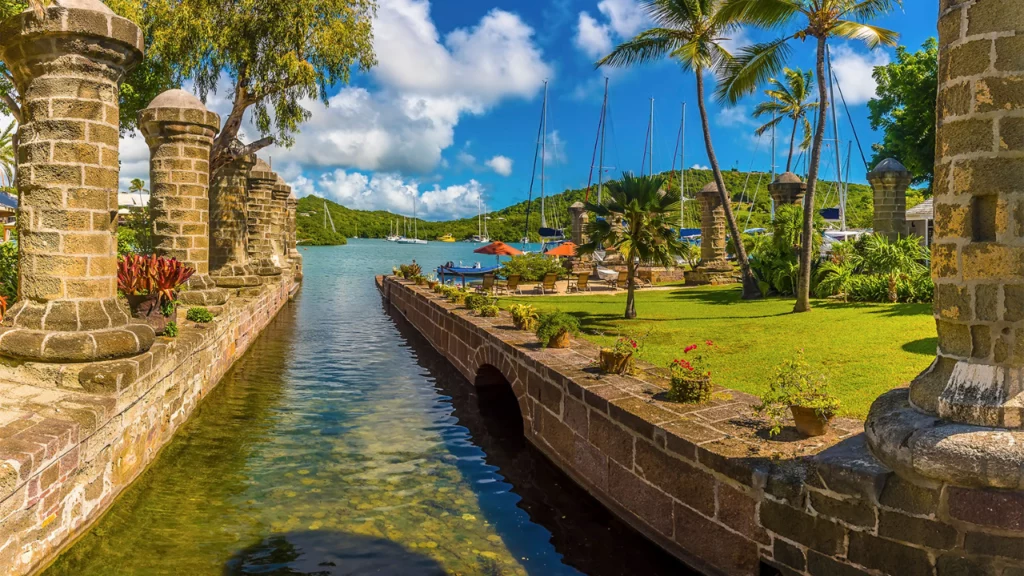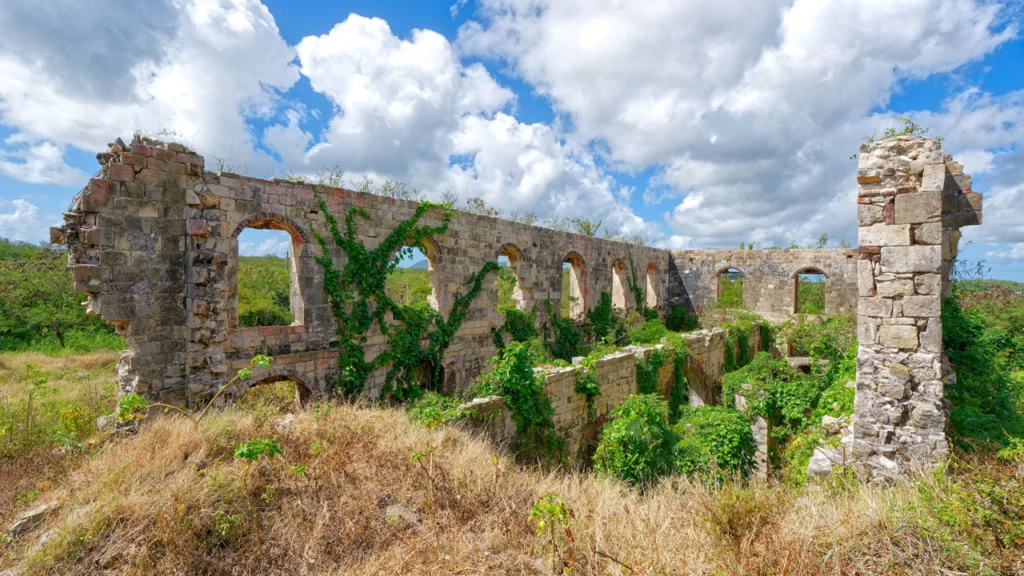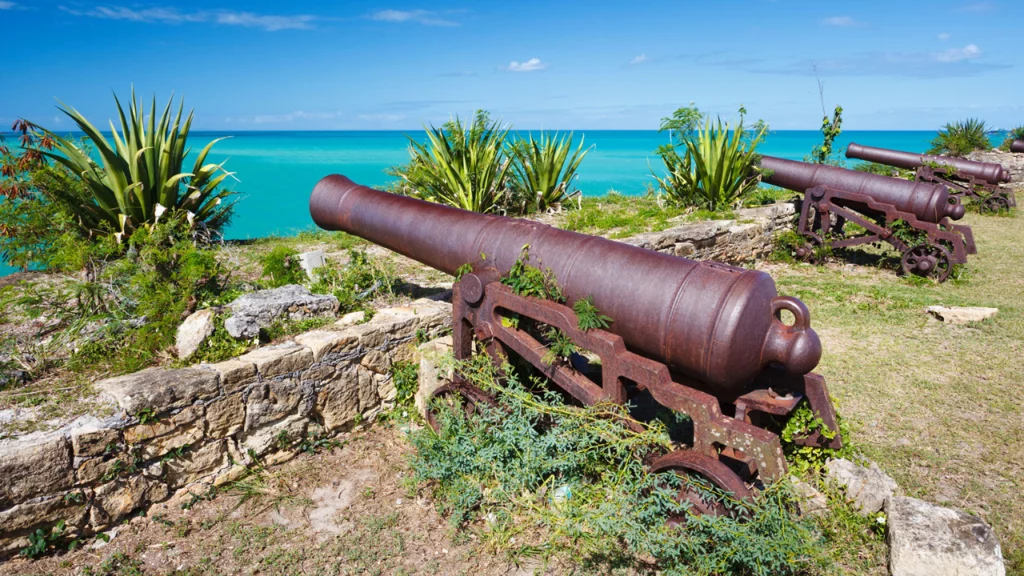Learn more about Antigua Barbuda history attractions. It is difficult to overstate how the arrival of Sir Christopher Codrington in 1684 impacted Antigua’s history. Codrington went to Antigua to know if the island supports large-scale sugar farming like elsewhere in the Caribbean.
His initial efforts proved quite successful, and over the next fifty years, sugar cultivation in Antigua exploded. By the middle of the 18th century, the island had more than 150 cane-processing windmills. Each is the focal point of a sizeable plantation.
Today almost 100 of these picturesque stone towers remain, although they now serve as houses, bars, restaurants, and shops. Visitors can see a fully-restored sugar mill at Betty’s Hope, Codrington’s original sugar estate.
Most Antiguans are of African lineage, descendants of enslaved people, and worked as laborers in the sugarcane fields. However, Antigua’s history of habitation extends as far back as two and a half millennia before Christ.
The first settlements, dating from about 2400 B.C., were those of the Siboney (an Arawak word meaning “stone people”). Nomadic Meso-Indians crafted shells and stone tools. Historical records indicate around the island are dozens of them. When Siboney moved, the agricultural Arawaks occupied Antigua between 35-1100 A.D.
Subsequently is the arrival of the Carib in Antigua. They were popular as aggressive people who ranged all over the Caribbean.
Christopher Columbus made the earliest European contact with the island during his second Caribbean voyage (1493). He sighted the island in passing. He named it after Santa Maria la Antigua, the miracle-working saint of Seville.
European settlement didn’t occur for over a century because of Antigua’s shortage of fresh water and determined Carib resistance. Finally, in 1632, a group of Englishmen from St. Kitts established a thriving settlement.

By the end of the eighteenth century, Antigua had become an important strategic port. As well as a valuable commercial colony and as the “gateway to the Caribbean”. It gains control over the major sailing routes to and from the region’s prosperous island colonies.
The island’s historical sites reflect the colonial efforts to ensure its invasion safety. These include its many ruined barricade and the restored architecture of English Harbour town.
Horatio Nelson arrived in 1784 at the head of the Squadron of the Leeward Islands. His orders were to develop the British naval facilities at English Harbour and to enforce stringent commercial shipping laws. The first of these two tasks resulted in the construction of Nelson’s Dockyard, one of Antigua’s finest physical assets. The second resulted in a rather hostile attitude toward the young captain.
Nelson spent most of his time in the cramped quarters of his ship, declaring the island a “dreadful hole.” Nelson built the Clarence House, which provided a more pleasant accommodation for the future King William.
During William’s reign, in 1834, Britain abolished slavery in the empire. Alone among the British Caribbean colonies, Antigua instituted immediate complete freedom rather than a four-year ‘apprenticeship’ or waiting period. Today, Antigua’s Carnival festivities commemorate the earliest abolition of slavery in the British Caribbean.
Liberation improved the island’s economy, but the sugar industry of the British islands was already beginning to wane. Until the development of tourism, Antiguans struggled for prosperity.
A strong labor movement in the 1940s, under the leadership of V.C. Bird, provided the impetus for independence. In 1967, with Barbuda and the tiny island of Redonda as dependencies, Antigua became an associated state of the Commonwealth.
In 1981 it achieved full independent status. V.C. Bird is now deceased.
This place is famous for a rambling array of gun emplacements and military buildings. Indeed, Shirley Heights is a breathtaking site. From the Heights, one can look far out over English Harbour. On Sunday afternoons, it’s best to have a barbecue, rum punch, and the resonant strains of steel band and reggae music.
Named after General Shirley, Governor of the Leeward Islands, when the area was fortified in the late eighteenth century. Close by is the cemetery, in which stands an obelisk erected in honor of the soldiers of the 54th regiment.
Antiguan folk pottery dates back to the early 18th century when enslaved people fashioned cooking vessels from local clay. Pottery is well-known in several places around Antigua. But the center of this cottage industry is Sea View Farm Village. In addition, pits nearby have plenty of clay.
Wares are finished through open fire in layers of green at the potters’ houses. Tourists can buy folk pottery in the outlets around the island. Buyers should know that Antiguan folk pottery breaks easily in cold environments.
Harmony Hall, in Brown’s Bay at Nonsuch Bay, is the center of the Antiguan arts community. Exhibits change throughout the year. The annual highlights are the Antigua Artist’s Exhibition and the Craft Fair, both in November.
The sugar mill tower around Harmony Hall converted into a bar. And it provides its patrons with one of the island’s best panoramic views, including a fine prospect of Nonsuch Bay.
This charming museum tells the story of Antigua and Barbuda from its birth to today. The museum is a calm oasis in the middle of St. John’s and contains various fascinating objects and exhibits. These range from a life-size replica of an Arawak dwelling to the bat of Viv Richards, one of the greatest cricket players ever. Visit their website at: www.antiguamuseums.net

Betty’s Hope was the first large sugar plantation in Antigua. Its success led to the island’s rapid development of sugar production. The only surviving structures are two stone sugar mills and the remains of the still-house.
However, the site’s importance in Antiguan history has prompted the government to develop it as an open-air museum. About a hundred stone windmill towers dot the Antiguan landscape.
The two restored examples at Betty’s Hope stand as a reminder of sugar’s long reign over the island. Betty’s Hope, built by Sir Christopher Codrington, who came to Antigua in 1674 from Barbados, and named after his daughter.
Indian Town Point, on the eastern coast, have been an Arawak campsite before the arrival of European colonists. Devil’s Bridge, a large, natural limestone arch on the shoreline of Indian Town Point, offers one of the most spectacular sights on the island. At high tide, the rougher waves of the Atlantic force enormous water geysers through boreholes in the rocks near the Bridge. Guided tours of the site are available.
Built-in the first half of the 18th century, this picturesque bastion has to guard the harbor of St. John’s. The walls remain in excellent condition, and a few cannons are still intact. But, the main attraction today is the excellent view of the surrounding harbor.
Nearby is Heritage Quay, which comprises a hotel, four duty-free shops, restaurants, and a casino. These are all part of the newest building in downtown St John’s.
Antigua’s most picturesque drive meanders. From the low central plain of the island up into the ancient volcanic hills of the Parish of Saint Mary in the island’s southwest quarter. The none-too-smooth road passes through an area of lush vegetation and rainforest and rises to the steep farmlands around Fig Tree Hill (figs are what Antiguans call bananas) before descending to the coastline again. Along the way are bananas, mangoes, coconut groves, old sugar mills, and pleasant little churches.
Although St. John’s has long been Antigua’s capital city, the island’s historic heart is across the island at English Harbour. One of the finest natural harbors in the Caribbean in a highly strategic position, English Harbour used by Admirals Nelson, Rodney, and Hood as a secure home for the British Navy during the Great French Wars.
Today, Nelson’s Dockyard forms part of a designated national park with a museum, shops, hotels, restaurants, and a yacht haven. The park embraces the whole of English Harbour and Shirley Heights.
The ‘megaliths’ that initially drew curious visitors to Green Castle Hill are almost certainly geologic features, but they are no less impressive and picturesque for being natural features. Green Castle Hill also provides an excellent view of the island’s interior. It includes the southwestern volcanic mass (of which it is a part) and the interior plain (due south of St. John’s, by the way, Jennings and Emanuel).
Those who visited Antigua may sail across to 365 beaches, one for each day of the year. The great majority rest inside the calm, protected waters of the island’s Caribbean side.
All are open to the public. So, the challenge to a visitor is not how to gain access to the best of them but how to locate the beach that suits one’s taste. Bringing a companion along to particularly isolated locations is wise.
Antiguans are knowingly reluctant to divulge their favorites, so here are several good starters. Be sure to acquire specific directions before you go.
Dickenson Bay and Runaway Bay, along the island’s developed northwestern coast, are ideal for fully-loaded resort beach experience. The beaches most convenient to St. John’s are Fort James, a locally famous public beach. While Deep Bay and Galley Bay attracts surfers during the winter months and joggers during the evening. The series of four crescent beaches at Hawksbill are also highly regarded, one of which is nudist.

The beaches of the hilly southwest corner of Antigua are generally less developed than those north of St. John’s. Fryes Bay, Darkwood Beach, and the beaches around Johnson’s Point are on the road that winds along this coast. Rendezvous Bay and especially Doigs Beach, located on the central southern coast, are tranquil beaches worth the rough travel to reach them. Near English Harbour Town, Pigeon Point is a convenient balm after a day at Nelson’s Dockyard.
Half Moon Bay is now a National Park and a good choice for a family outing on the island’s southeast corner. Long Bay, on the island’s easternmost point, is another good choice for families, as its reef completely protects it.
Barbuda’s smooth coastline has long pink and white sand beaches protected by barrier reefs. The pristine pink beaches of the southwestern shore stretch as far as ten miles without interruption. The beaches of the eastern shore, facing the Atlantic, are somewhat rougher, although they are outstanding for beach-combing.
Contact Us to book your Antigua and Barbuda yacht charter adventure. In addition, Antigua has a wide selection of first-class resorts.
Return to Top
Contact us at 1-321-777-1707 or complete this form to discuss your vacation plans.